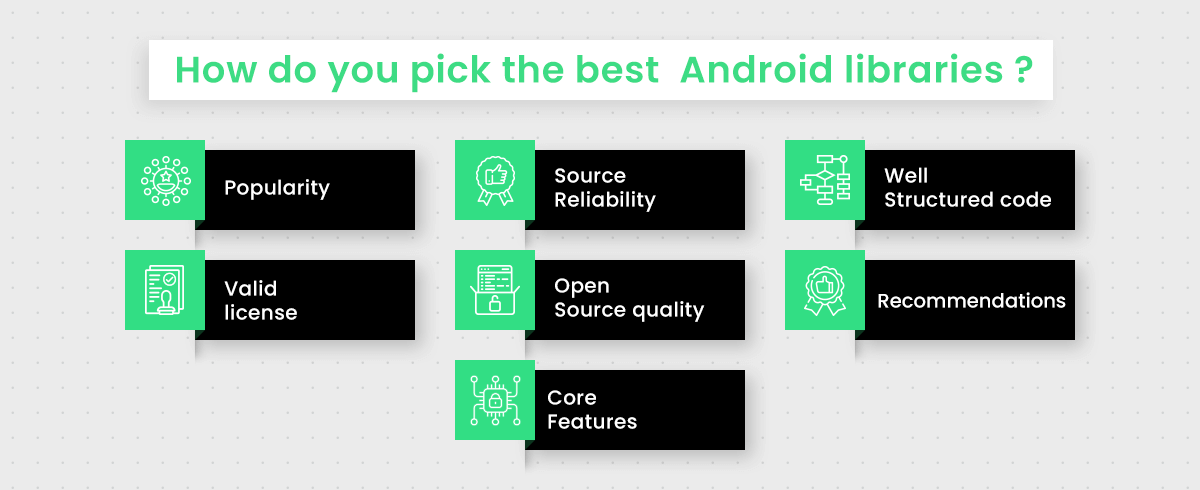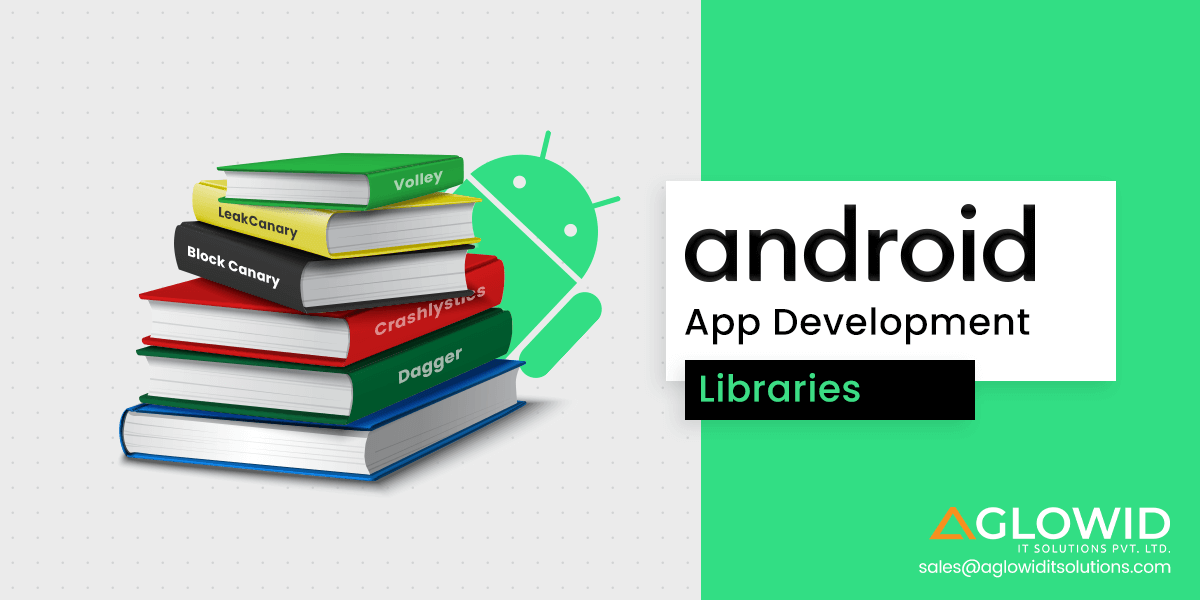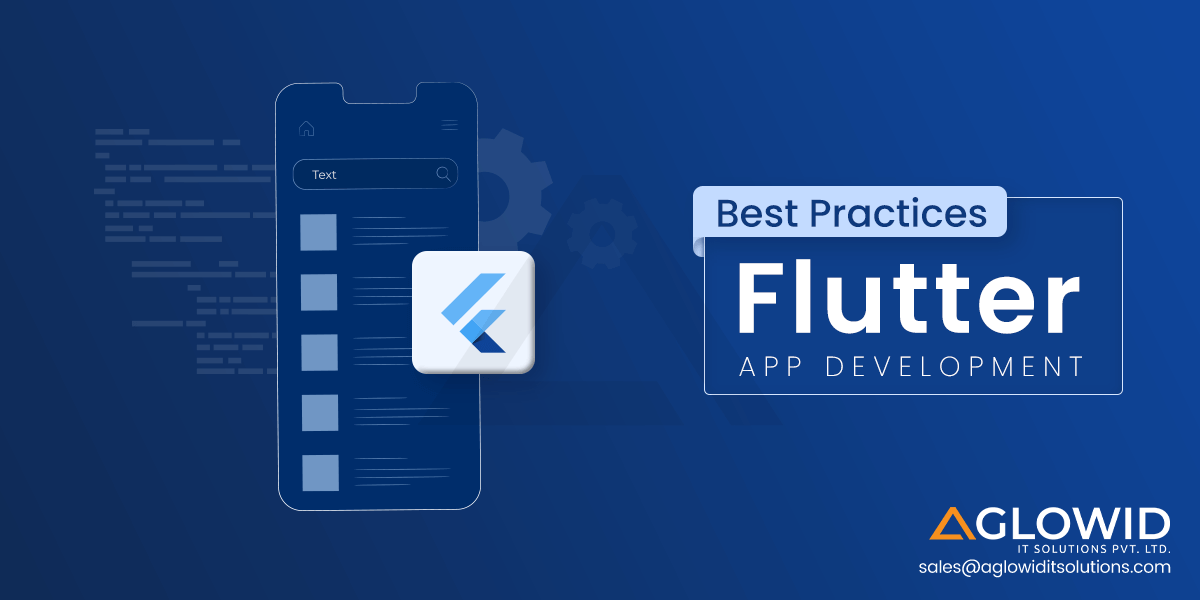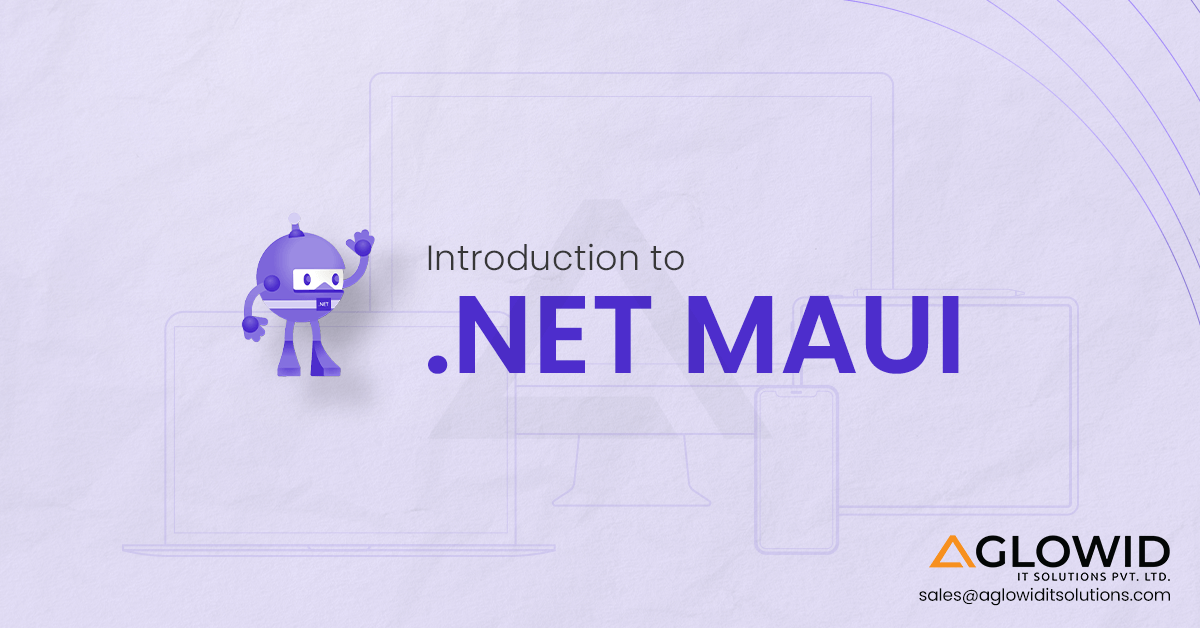Quick Summary: When it comes to Android libraries and frameworks, they are the tools that assist developers in creating apps faster by defining numerous components of the app, such as UI elements, debugging, and so on. Detailed documentation, configuration data templates, the installation process, and other features are frequently included in such libraries.
Being an Android developer is a difficult job. To construct an industry-standard working application, you’ll need to be familiar with libraries, languages, and other tools. Android app libraries make the development process easier for developers. To summarise, android libraries and frameworks are a collection of behaviour implementations written in a programming language with a well-defined interface.
According to Statcounter, Android holds 72.21% of the market share. These figures demonstrate the popularity of Android and the enormous demand for Android apps.
One of the main reasons for adopting Android libraries is to speed up and optimize the development of Android apps. Instead of executing these activities from the start, these Android best libraries provide developers with basic pre-written code or other pieces that they may use immediately.
Before we go into the topic of android libraries, let’s define what android libraries are?
What are Android Libraries?
An android library and an android app module have the same structure. It can include source code, resource files, and an Android manifest, among other things. However, instead of compiling to an apk file installed on an Android device, it is built into an Android Archive (AAR) file that you may use to depend on the Android app module.
Example: Android Jetpack libraries
Jetpack is a suite of libraries to help developers
- Follow best practices,
- Reduce boilerplate code,
- Reduce fragmentation
While writing code that works consistently across android versions & devices to focus on the code, jetpack includes some of the following libraries.
- Activity: Access composable API built on top of Activity.
- Appcompat: Allows access to new APIs on older API versions of the platform.
- App search: build custom in-app search capabilities for your users.
How do you Select the best Android Libraries For your Project?
Whether you require a performance library, a testing library, or another type of library, consider the following considerations when choosing the ideal libraries for your purposes.
When selecting a library, keep the following checklist in mind.

Popularity
Examine the ratings for the potential library and the amount and severity of issues reported – in most cases, if the majority of developers enjoy it, and it’s a good sign of quality.
Source Reliability
Check out the author before making your decision to reduce the chance of a low-quality library. It is an excellent indicator of quality when a library is popular among developers.
Well structured code
Ensure the library is well-structured before utilizing it and that the readme files are complete and up-to-date for a smoother and easier integration.
Valid license
Because library usage is restricted, licensing may also play a role in your decision. Make sure you’re following all of the terms of the library you’re using in your project.
Open source quality
Access the library’s source code and review it for performance or quality. If you find the lack of transparency, it could be a sign of security risk.
Recommendations
Most platforms have several libraries already installed, and the best part is that they are well-maintained and documented. These libraries are low-risk but do your homework to learn about their features, limitations, and advantages.
Core Features
Don’t worry about having complete control over the code; libraries will cover many scenarios. However, because you can’t afford to skimp on performance, it’s best to stick with the tried and true libraries.
Best Android Libraries Based on Categories
Now that we have seen how to select the best android library. Let’s dive into the list of android libraries. In this post, libraries are divided into 13 categories along with android libraries GitHub link. They are as follows.

- Performance
- Caching
- Crash Reporting
- Dependency Injections
- Gradle
- Networking
- Image Loading
- Scanning
- View binding
- Debugging
- Drawing
- Testing
- UI/UX
1. Performance
Performance is critical for any android application. Users anticipate a quick and responsive app. However, 70% of mobile app users abandon an app if it takes too long to load – Google. Furthermore, 25% of users abandon apps after one use due to poor performance. These numbers show the significance of the performance. Let’s see some of the performance libraries.

Leak Canary
LeakCanary is a memory leak detecting library for Android and Java. LeakCanary’s understanding of the Android Framework’s internals provides it with a unique ability to pinpoint the source of each leak, allowing developers to reduce OutOfMemoryError crashes significantly.
Block Canary
Block Canary is a lightweight, non-intrusive performance monitoring component. It is an android UI-block detection library that requires only one line of code to start up. Block Canary is entitled to honour the excellent library Leak Canary, and the UI-related codes have been updated from leakcanary’s UI component. The max log count is set to 500, but you can change it according to your preference in the int.xml file.
ANR watchdog
ANR watchdog is an application not responding (ANR) detecting library. Currently, there is no way for android applications to find & report ANR errors. If your application is not in the play store, the only way to investigate the ANR is to pull the file/data/anr/traces.txt. It sets up a “watchdog” timer that will detect when the UI thread stops responding. When it does, it raises an error with all the thread’s stack traces.
2. Android Caching Libraries
Following is the list of caching libraries used by the developers.

CacheX
For Android, a practical caching library is available. Simple key-value pair data-saving technique, caching is. As a data caching mechanism, CacheX makes use of the SharedPreference class. For security reasons, we are unable to save the original data on our computer. When you cache data or fetch data from the cache, CacheX uses AES encryption & decryption. Cache data can be observed in real-time.
Cold Storage
Cold storage is a lightweight caching library. A method can be annotated to cache its output, and the class can be annotated to cache the outputs of all methods in the class. The cache can be configured by setting the expiration time and maximum size.
Coroutines Cache
Cache coroutines for Kotlin android is a powerful caching library. Coroutines cache, a reactive caching library for Android, is inspired by Retrofit and RxCache and turns your caching needs into simple functions. In supplying a deferred containing the data provided by a costly task, most likely an HTTP connection. If a request is made to it, CoroutinesCache determines if the request should be executed or if the data should be retrieved. Then, based on the CachePolicy, a decision is made.
3. Android Crash Reporting Libraries
Crash reporting is an essential concept for the development process. If the crash is not reported, then the effort is wasted.

Crash Reporter
App crashes can be captured and saved with CrashReporter. We experience crashes while working on application features, and if the device isn’t connected to logcat, we won’t be able to view the crash log. Therefore, it’s a waste of time if the crash is not recorded. Each unhandled crash is saved locally by this library. Other libraries capture crashes and upload them to the server, but some crashes aren’t logged. For this reason, this library is intended to be used as a debugging tool for capturing crashes locally and instantly.
ACRA
Automated Crash Reporting for Android (ACRA) is the acronym for this feature. This free library allows you to solve the “manual error reporting” issue in a few lines of code. You’ll be able to extract the same Android error logs as Google by default (plus additional customization options) automatically and without requiring the user to take action once you’ve implemented the library and everything has been properly initialized. In Summary, we can say that. When an Android app crashes, ACRA will automatically send a report to a report server. If your Android app crashes, it will assist you in retrieving the data from your app’s memory. ACRA has 1.21% of market share all over
Crashlystics
Crashlystics is the crash analysis tool for Android. Is there a difference between it and Fabric and Firebase crashlytics? To avoid having to deal with crashes in the background, this library allows the developer to do their work in a separate thread whenever a crash occurs instead. This is because other crashlytics tools can access only the devices and stack traces. On the other hand, this library allows developers to identify the device, user information, and much more when a crash occurs.
4. Dependency Injections
Why don’t we take a minute to learn what Dependency Injector is before moving on to the Android studio library list of best and latest Android libraries 2021 for Dependency Injector?
Dependency injection (DI) is a widely used programming technique for Android development. Following the ideas of DI, one may develop a decent android library architecture for apps.

Android Annotation
AndroidAnnotations is a free, open-source framework for Android app development. It takes care of the plumbing, enabling you to concentrate on the more essential aspects of your life. In addition, simplifying your code makes it easier to maintain.
Dagger 2
One of the best things about Dagger 2 is that it estimates and analyses dependencies primarily utilizing Java annotation processors and compile-time. Other Java dependency injection libraries, on the other hand, have restrictions such as reliance on XML, performance penalties during startup, and runtime dependency validation difficulties.
Another benefit of Dagger 2 is that it makes it easier to access shared instances. For example, once you’ve declared singleton instances in Dagger, such as MyTwitterApiClient or SharedPreferences, you may quickly declare fields using the @Inject annotation:
Dagger
A quick Java and Android dependency injector. Dagger is a dependency injection framework that runs at compile time. It generates simple Java source code and does not employ reflection or runtime bytecode creation. It does all of its analysis at compile time.
The same team that maintains Guava also maintains Dagger. Therefore, every clean build with the version HEAD-SNAPSHOT is automatically deployed to Sonatype’s central Maven repository. The present version is based on prior Square work. It also adds code to allow dependency injection to every non-bean class with at least one @Inject annotation during this stage.
5. Gradle
Following are the libraries that can help you with Gradle. But before we deep dive into libraries, let’s first understand what Gradle is.
Gradle is an open-source build system for automated building, testing, and deployment. “Build. Gradle” are scripts that allow you to automate tasks. Gradle build scripts can, for example, conduct the simple action of copying files from one directory to another before the actual build process begins.

gradle-protobuf-plugin
This is a Gradle plugin that allows you to compile Google Protocol Buffer. Proto files into data access classes. The. Proto files in src/main/proto are used to build Java, CPP, and Python source files.
This plugin makes the Java plugin a dependency for it to compile the generated Java source files. It creates a sources jar that contains all of the Java sources in this project (including those generated from. proto files).
For the plugin to work, the Protocol Buffer compiler must be installed. If the protocol buffer is located somewhere else, make sure to include the entire path to the compiler in your build. protobuf.compiler = ‘/full/path/protoc’ in the Gradle file
gradle-play-publisher
GPP is an unofficial Gradle plugin for Android release automation. It can perform anything from creating, upload, and promote your App Bundle or APK to publish app listings and other metadata. You can get more details about this plugin here.
dexcount-gradle-plugin
On every build, a Gradle plugin will report the number of method references in your APK, AAR, or Java module. This allows you to keep track of your app’s growth while staying within the 65,536 method-reference restrictions and avoiding the hassle of having to remove methods or enable multidex. For more information, please visit here.
The plugin is accessible from Maven Central under the coordinates com.getkeepsafe.dexcount:dexcount-gradle-plugin:3.0.0 and the Gradle Plugin Portal via the ID com.getkeepsafe.dexcount.
Snapshot builds can be found at https://oss.sonatype.org/content/repositories/snapshots at the Sonatype Snapshot Repository. Java 8 or higher, Gradle 6.0 or higher, and Android Gradle Plugin 3.4.0 or higher are all required for Dexcount.
6. Android Networking Libraries
Within the Android app, you’ll find the tools you’ll need to establish any type of network communication.

Android Volley
Android Volley is an HTTP library for Android apps that make networking easy and, most importantly, faster. It can be found on GitHub.
Volley excels at RPC-type operations used to populate a UI, such as getting a page of structured search results. It works with any protocol and includes support for raw strings, pictures, and JSON out of the box. In addition, Volley frees you from creating boilerplate code by providing built-in support for the features you require, focusing on the logic unique to your app.
Because Volley retains all responses in memory during parsing, it is not ideal for big download or streaming activities. Instead, consider utilizing DownloadManager as an option for substantial download operations.
The primary request dispatch pipeline and a set of typically relevant utilities are provided in the Volley “toolbox,” which is developed on GitHub. Adding Volley to your project is as simple as adding the following dependency to your app’s build. gradle file:
For Kotlin:
dependencies {
…
implementation(“com.android.volley:volley:1.2.1”)
}
For Groovy:
dependencies { … implementation ‘com.android.volley:volley:1.2.1’}
Retrofit
Retrofit is a type-safe REST client for Android and Java that uses annotations to translate an API into a client interface intelligently. For example, if you wanted to perform a network request before, you had to utilize an Async task class and then use HttpsUrlConnection to fetch data, which was inconvenient when dealing with APIs that returned significant amounts of data.
Retrofit has now solved the problem. With mere annotations, one can easily alter endpoints and headers, add a request body and query parameters, and pick request methods in Retrofit. Furthermore, utilizing converters, this Android library takes care of parsing POJOs.
Begin by including dependencies in your build. gradle file after adding the dependent to your app’s build. gradle file, you’ll need to add a dependence for any converters you plan to use.
Activity Recognition API
This API allows users to identify their current activity, such as walking, driving, or simply standing motionless. In addition, android developers that use this library can use the ‘Request Updates’ button to request activity updates and the ‘Eliminate Updates’ button to stop receiving updates.
In addition, the sample uses an IntentService to handle activity modifications sent via ActivityRecognitionResultobjects. The IntentService will compile a list of all potentially identified exercises and send it to a BroadcastReceiver.
7. Android Image loading Libraries
Android Image libraries are a saviour in the fight against “out of memory errors” in Android apps caused by loading several photos at once. Let’s take a look at some of the top Android library alternatives available.

Picasso
Picasso is a trustworthy and extensively used Android image library maintained by Square. In addition, Picasso claims to make picture loading in the app simple—often with just one line of code.
Handling ImageView recycling and downloading cancellation in an adapter, supporting sophisticated image modifications with minimum memory, automated memory, and caching are some of the issues that Picasso avoids. In addition, Picasso has several additional capabilities that make it a popular choice among Android app developers.
- Picasso identifies adapter reuse and previously aborted downloads automatically.
- It converts images quickly and effectively to make them fit better into layouts and save memory usage.
- Custom transformations can be specified for more complex effects.
Glide
Bumptech’s Glide is yet another highly appreciated image loader and one of the developers’ most significant new Android libraries. Not only that, but it is also directly endorsed by Google.
Glide not only supports animated GIFs while loading and caching images, but it also assists with retrieving, decoding, and displaying video calls, images, and these GIFs. It also has a versatile API that allows developers and programmers to use any network stack instead of the default HttpUrlConnection.
This library’s primary goal is to make scrolling through any list of images as smooth as possible. However, it’s also useful if you need to retrieve, resize, or even display a distant image.
8. Android Scanning Libraries
Developers choose the libraries listed below to incorporate scanning functions into bespoke Android apps and boost their functionality.

Zxing
ZXing (short for ‘Zebra Crossing’) is an Android barcode image-processing library written in Java with ports to other programming languages. This library also supports the 1D product, 1D industrial, and 2D barcodes
Google also uses ZXing to index millions of barcodes on the web. It’s also the foundation for Android’s Barcode Scanner app, Google Book Search, and Google Product.
CAMview
CAM View is a good substitute for the ZXing barcode scanner. It’s a ZXing-based Android camera accessible access library with an inbuilt QR scanner. This library has a set of components (views in plain terms) that are ready to be added to your layout files, allowing developers to quickly access-
- The device camera’s live preview video feed
- ZXing’s built-in decoding engine is used to scan barcodes.
- To handle live data from a camera on your own
9. View binding libraries
When the desire to reduce boilerplate code when assigning views to variables developed, the demand for view binding libraries arose. There is a slew of Android support libraries worth noting for this purpose, with two of the most prominent being:

View binding
The Android Jetpack libraries include view binding. It’s a feature that lets you build code that interacts with views quickly. When view building is enabled, a binding class is created for each XML layout file in the module. A binding class instance holds a direct reference to all views in the relevant layout with an ID. Thus, view binding creates a binding class that has a direct connection to view.
On the other hand, view binding is designed to handle more straightforward use cases and has the advantages of faster compilation and ease of usage. Butterknife Android was popular before view binding and is still popular today. It is, however, deprecated, and view binding is advised instead.
Android data binding
The android data-binding library, which is part of the android support library, requires Android Studio version 1.3 to work. This view binding library for Android, unlike Butterknife Android, does not use annotations. It lets you use a declarative style instead of programming to tie UI components in the layouts of data sources in the app. In this case, layouts are declared in activities that need UI framework methods.
10. Android Debugging Libraries
Debugging is one of the most crucial processes in the app development process, and it is critical to debugging an app before it is released. Let’s look at a few of the most valuable libraries.

Sthetho
Stetho is a “sophisticated debug bridge for Android applications,” according to the company. Developers use this module to access the Chrome Developer Tools features that are natively part of the Chrome desktop browser, rather than only Network inspection, Database inspection, JavaScript Console, and so on. Developers can also enable the dump app tool, which provides a powerful command-line interface to the application’s internals.
Hyperlog-android
This standard Android Log class allows you to store logs in an Android database library and send them to a remote server for debugging. It’s also a logger utility library.
This library provides end-to-end visibility and aids in the resolution of problems. The HyperTrack SDK sends logs to the Hyperlog server, which processes them and displays them on Kibana using the ELK stack.
11. Android Chart Libraries
There are hundreds of new libraries being developed every day, but very few can impress developers and prove the point. Here are some android chart libraries that stood apart from the crowd.

MPAndroid Chart
MPAndroidChart is a fantastic chart/graph visualization library for Android. Radar, line, bar, bubble, pie, and candlestick charts are all supported, as well as scaling, animations, and dragging. Charts is the one for iOS app development if you’re looking for its iOS counterpart.
Holo graph library
It’s another new visual library that’s quickly becoming popular among Android app developers. This library is perfect for incorporating beautifully designed graphs and charts into Android apps. It consists of –
- LineGraph View
- BarGraph View
- PieGraph View
- MultiSeries Donut Graph
AnimatedPieView
AnimatedPieView is yet another method for showing pie charts and ring graphs on Android. This library offers various benefits like On touch alpha animation, Automatic fitting text field position during animation, transforming pie chart to ring chart, animation while creating charts, and so on.
12. Android UI Libraries
The user interface is a crucial part of Android app development that cannot be overlooked. Over time, breakthroughs and advancements in android libraries for UI domains have emerged, Gravity View.

Gravity View
The Gravity View is a popular notion in the industry. This is an Android user interface library for image tilting with sensors. The Gravity View library’s objective is to take advantage of Android’s motion sensors, allowing users to execute various tasks by spinning their devices. This Android UI library was first utilized in the well-known application “Fynd” and has grown in popularity. To use this library, you must have Android 3.0 or above installed. Furthermore, you may use the Accelerometer sensor to use it with non-gyroscope devices.
Dynamic Support
Dynamic Support is a complete library to build apps for android devices with a built-in theme engine. It is built on top of the latest app compact library to provide the best compatibility.
It is a collection of activities, fragments, widgets, views, and some utility functions required to build a standard android app.
Synth
Synthesis is a CRED’s inbuilt library for using neuromorphic components in the application. But what exactly are neuromorphic components? It’s an impressionistic style, playing with light, shadows, and depth to create the digital experience inspired by the physical world. You can install synth by adding this to your build. grade file:
dependencies{
implementation ‘club.cred.android.sy
}
13. Android Testing Libraries
Testing your app is an excellent approach to ensure that it is of good quality and performs well. These libraries can be used to test your mobile app before releasing it to the public.

Espresso
An espresso is a tool that is included in the Android testing library. It’s a test framework that allows Android app developers to create user interface tests. This library allows you to construct tests to see if a TextView is comparable to that of another text. It gives the idea that a natural person is using the program and works on both real devices and emulators. You must add dependencies to the app module build to use this library. The key benefit of using expresso is that it provides automatic synchronization to test actions with the UI of the app you’re testing.
Robolectric
Another popular unit testing library is Roboelectric. This library controls resource loading inflation, as well as other things. In addition, it improves the efficiency of the library’s tests in performing functions that are performed by proper Android framework dependencies.
In conclusion, Robolectric simulates Android SDK for testing, preventing the necessity for a separate framework such as Mockito. In the build.gradle file of your project, you must add dependencies.
Some Useful Resources Where You Can Find More Android Top Libraries.
- Android Arsenal
- Android Wasabeef Core Libraries
- Wasabeef UI Libraries
- Ultimate Android Library Reference
- Snowdream Android Library Repository
- Android Libhunt
- MindOrks Android Store
Looking for Android App Developers to develop cutting edge native app?
Hire Professional Android App Developers from Aglowid to develop highly scalable and performance-oriented mobile app project.
Wrapping Up
These are a few Android open-source libraries that you should look into. Using these native libraries can save you a lot of time and work when developing an Android app from the ground up. In addition, using these Android libraries, developers may construct responsive and efficient mobile apps that save time and effort.
However, if you have any questions about the Android development process or how to publish an app on the Play Store, you may contact our team of specialists, who will assist you in resolving any issues you may have.
Also Check:





 Say
Say